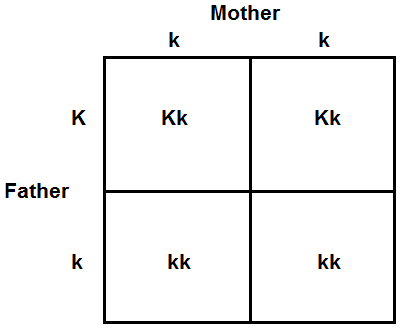Autosomal Dominant Inheritance Calculator

The autosomal dominant inheritance calculator calculates the risk that a child has of developing a disease if the disease is an autosomal dominant disease
Autosomal dominant diseases are diseases in which a child receives an abnormal faulty gene from either the father or mother and, therefore, develops the disease.
The reason it is called dominant is because only one parent has to have an abnormal, mutated gene in order for the child to get the disease. The other parent could be completely normal and unaffected and have normal genes. As long as one parent has a faulty gene, the child can obtain the disease.
Autosomes are the first 22 pairs of chromosomes that exist in a human being's DNA. A healthy, normal human being has 46 chromosomes. The first 22 pairs of chromosomes (composed of 44 chromosomes) are referred to autosomes, or non-sex chromosomes. The last pair are the sex chromosomes. Human beings have 2 sex chromosomes.
Defects in any of the autosomes of the human body can cause disease, as is evidenced by autosomal dominant disorders.
Many disorders are autosomal dominant disorders including polycystic kidney disease, neurofibromatosis, Huntington disease, and Marfan syndrome.
Autosomal dominant diseases are diseases in which only one parent needs to contribute an abnormal gene in order for a child to have the disease. If only one parent has the disease and the other doesn't, the child can develop the disease.
So now we'll go through each of the possibilities of how breeding can go.
If neither parent has the abnormal gene, the child has no chance of developing the disease.
If one parent has the abnormal gene and the other parent is normal, the child has a 50% chance of developing the disease. The child also has a 50% chance of being completely normal and unaffected.
Specifically, in the 50% chance that the child has of developing the disease, the child will receive one faulty gene and the other will be normal. In the 50% chance of the child being completely normal and unaffected, both genes will be normal.
If both parents have the abnormal gene, the child has a 75% of developing the disease and a 25% chance of being completely normal and unaffected.
Specifically, of the 75% chance that the child has of developing the disease, there is a 50% chance the child will receive one faulty gene from one part and a 25% chance a child will receive a faulty gene from both parents. In the 25% chance case that the child does get a faulty gene from both parents, the child may have severe symptoms, worse than the parents, and may not survive; this represents the worst case. In the other 50% chance that the child develops the disease, the child will receive a faulty gene from one parent. The child will most likely have similar symptoms to the parent. In the 25% cchance of the child being completely normal, both genes will be normal.
That exhausts all the possibilities that exist for autosomal dominant disorders.
Genetic testing is available to determine if parents carry certain genes and are at risk for conceiving a child with an autosomal dominant disorder. However, due to many factors such as unplanned pregnancies, this often isn't sought which is why many children are still born with these autosomal dominant disorders. But genetic testing is widely available and is encouraged for parents in the pre-planning phase for conception to allow for the healthiest, disease-free child.
Despite genetic testing being widely available, autosomal dominant disorders are still very prevalent.
Huntington diease is an inherited disease that causes the progressive breakdown (degeneration) of nerve cells in the brain. It impacts a person's cognitive, functional (movement) abilities, and may cause psychiatric problems. Movement disorders may include involuntary jerking or writhing movements called chorea, muscle problems such as rigidity or contractures, abnormal eye movements, impaired gait, posture or balance, and difficulty with speaking or swallowing. Cognitive disorders include difficulty focusing, impulsiveness, and difficulty learning. Psychiatric disorders may include depression, obsessive-compulsive disorder, and bipolar diosrder. All of this is brought on by a defective gene transmitted by a parent or both parents, which cause degeneration of the brain.
Neurofibromatosis is a inherited condition that causes tumors to form in the brain, spinal cord, and nerves. These tumors can develop in any of these 3 places. Neurofibromatosis is classified into different types. Type 1 can cause bone deformities, learning disabilities, and high blood pressure. Type 2 can cause hearing loss, vision loss, and difficulty with balance. Type 3 can cause chronic pain throughout the body.
Polycystic kidney disease (PKD) is an inherited disorder in which clusters of cysts develop in the kidneys. PKD is a progressive disease in which the kidneys function worse and worse over time. In the end, it can lead to end stage renal (ESR) failure. In this case, the person would either need dialysis or a kidney transplant in order to stay alive. Symptoms of PKD may include hypertension, back or side pain, and a swollen abdomen. Some people may experience fatigue, hematuria (blood in the urine), and a lump in the abdomen.
Marfan's syndrome is a disorder that affects connective tissue throughout the body. Marfan syndrome affects the heart, eyes, blood vessels, and bones. People who have Marfan's syndrome are tall and thin with long arms, legs, fingers, and toes. They may have a bulging or sunken chest. The biggest complication associated with Marfan's syndrome is aortic aneurysm and dissection. This is when the aorta stretches so much that it balloons and can burst. This would cause massive hemorrhage and almost certainly will be fatal.
There are many more autosomal dominant disorders.
The point is, with proper education, awareness of testing can be done to help decrease these diseases that can plague our children.
Related Resources
Autosomal Recessive Calculator
Naegele's Rule Calculator
Bartholomew's Rule of Fourths Calculator
